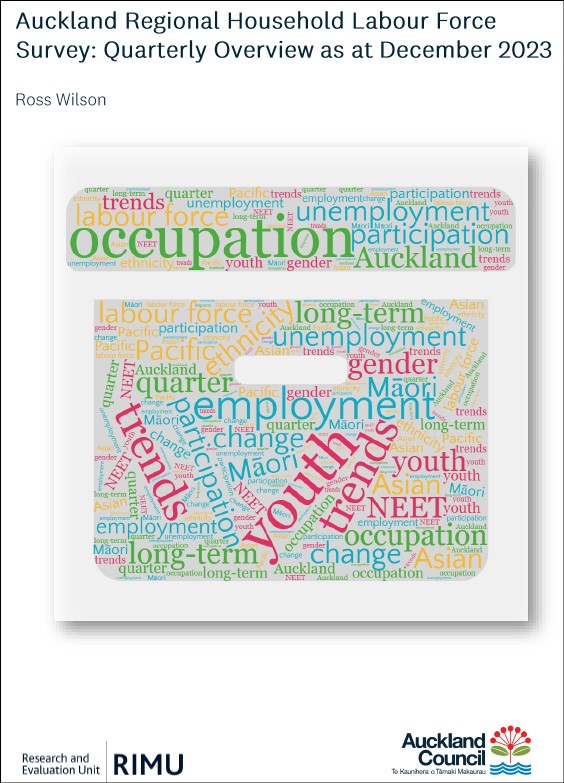Auckland regional household labour force survey: quarterly overview as at December 2023
Author:
Ross WilsonSource:
Auckland Council Research and Evaluation Unit, RIMU | Statistics New ZealandPublication date:
2024Topics:
EconomyAn overview of labour force participation in Auckland, as indicated by results of Stats NZ's quarterly Household Labour Force Survey. HLFS
Overview and highlights
For the December 2023 quarter, compared to the preceding quarter (September 2023):
- Auckland's unemployment rate was 4.2%, slightly² higher than 4.0% in September 2023, (but lower than nearly all of 2008 to 2020).
- The number of people who were unemployed rose to 44,100 (+2,800).
- The number of people employed rose to 1,011,200 (+12,400; full-time+14,400).
- The number of people not in the labour force (NILF) fell to 358,900 (-4,500).
- The labour force participation rate (LFPR) rose to 74.6%, the highest December quarter on record (since at least 1995). LFPR since 2021 have been at record levels.
In addition, for the December 2023 quarter:
- The rate of people aged 15 to 24 not in employment, education or training (NEET) was 12.9%, slightly above the rest of New Zealand (12.2%).
Over the year ended December 2023, compared to the year ended December 2022:
- The unemployment rate averaged 3.8%, higher than a year earlier (2022: 3.4%).
- The unemployment rate rose for people aged 55 and over (+1.0% to 2.6%), and also for those aged 25 to 39 (+0.4% to 3.2%) and 40 to 54 (+0.4% to 2.4%). Rates for young people aged 15 to 19 were unchanged (16.0%) but still the highest.
- The unemployment rate for females averaged 4.2%, similar to the previous year (4.0%). The rate for males averaged 3.5% (slightly above 3.0% a year prior), so the gap between males and females (0.7%) remained similar to the 20-year average (0.8%).
- Unemployment rates and changes varied between ethnic groups: the rate rose slightly for Maori (to 8.4%) and Pacific peoples (to 7.0%); Asian peoples rose by more (to 3.4%), overtaking European peoples (2.8%) who had minimal change;.
- The labour force participation rate (LFPR) averaged 74.5%, higher than a year earlier (72.9%) and currently the highest it has been in at least 28 years.
- The labour force participation rate for females (69.9% - a new record) rose (up 1.7% from 68.2%); for males (a record 79.1%) it also rose, but by less (up 1.3% from 77.8%).
- Labour force participation rates rose for all age groups except those aged 15-19 (similar at 46.6%), especially those aged 20-24 (81.1%, up 1.3%), 25-39 (88.3%, up 1.3%) and 55+ (52.7%, up 1.2%). Rates for all age groups were at or near record highs.
- Labour force participation rates by ethnic group rose for European (75.5%, up 1.7%), and slightly for Asian (78.1%, up 0.9%), Maori (69.2%, up 0.5%) and Pacific (67.2%, up 1.1%). All groups have been at or near record levels in 2022 and 2023.
In addition, over the year ended December 2023:
- The annual average NEET rate for Auckland was 11.5%, similar to the rest of New Zealand (11.7%), and slightly below the year ended December 2022 (11.9%).
- Auckland NEET rates were highest for Maori (21.2%) and Pacific (17.4%) ethnicities, and for the Southern Initiative area (18.6%).
- Auckland's NEET rate was higher for those aged 20-24 (14.2%) than 15-19 (8.8%).
Overview published February 2024.
